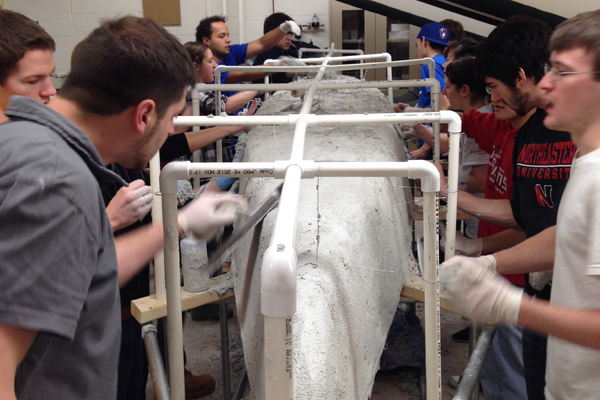Take 5: How to build a concrete canoe

Northeastern’s concrete canoe team will participate in the American Society of Civil Engineers’ 2014 New England Regional Concrete Canoe Competition at Bare Hill Pond in Harvard, Mass. on April 26. More than a dozen teams, from Boston to Quebec, will be judged on canoe design, a written report, an oral presentation, and the craft’s performance in five endurance races. The winner will move on to the national competition, which will be held in June at the University of Pittsburgh at Johnstown. Here are five things you should know before the competition begins.
Time well spent
A team of 30 Northeastern students spent 5,000 man-hours designing and fabricating the canoe on a $4,000 budget. The group used two types of cement, glass spheres, latex, and water to make a durable, low-density, and environmentally friendly concrete mix. Working on the canoe, said project manager Andrew Brunn, E’14, was a “great way to get my hands dirty and build camaraderie in an academic setting.”
Why bigger isn’t better
The canoe is 18 feet long and weighs 245 pounds, some 25 pounds less than last year’s craft. To decrease the weight, the team spent 500 hours sanding the canoe, reducing the thickness of the concrete from three-fourths of an inch to one-half an inch. The result, Brunn said, is a lighter yet stronger vessel, one that can hold at least 800 pounds.
What’s in a name?
The team nicknamed the canoe “Incendia,” the Latin word for the phrase “to ignite.” A few members helped paint a large phoenix on the bottom of the boat, a tribute to the group’s growing strength. “Last year was the first time in recent memory that our canoe stayed together in competition,” Brunn said. “This year, we are building off that success.”
Built to last
Incendia is too fragile—and too expensive—to use in practice for the endurance races, but that doesn’t mean the canoe is not built to last. In fact, Brunn said, “It could be your regular pleasure craft on the lake. It’s structurally sound, so you could paddle for days.”
The expert’s prediction
The team’s written report—an 18-page account of eight months of work in charts, graphs, photos, and text—is “phenomenal,” in Brunn’s words, and the group’s oral presentation figures to be “outstanding.” What remains to be seen is the team’s performance in the endurance races, but Brunn has high hopes. “I think our canoe will look great, and we’ll compete with the best,” he predicted. “We’ll see where we wind up and hopefully we can get to the national championship.”